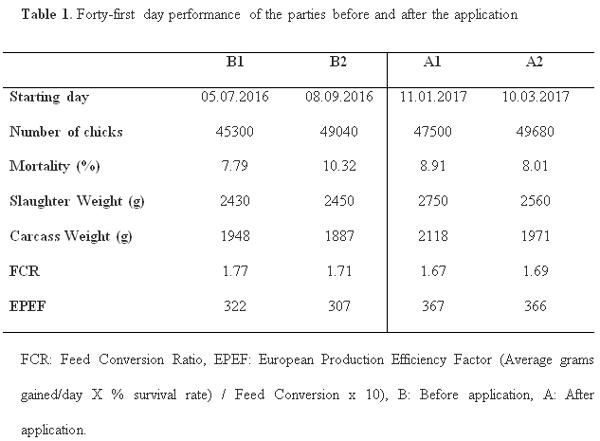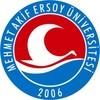DESCRIPTION OF PROBLEM
Farm animals need optimal environment for development and growth in order to reach their genetic capacity. Any weakness of the components of environment may decrease the performance. Consuming water is one of the main pillars of the obtained performance.
Importance of consumed water by animals during the growing and fattening period is a reality in the whole livestock sector. Water is considered as nutrient and essential element for all the metabolism activity. This importance also shows itself in the short-term life of broiler chicken. According to general knowledge, chicken consume double amount of water than their food. This amount is variable according to environmental factors. This fact makes the quality and quantity of the water more important. Many researchers have mentioned the importance of drinking water and its quality on various aspects for broiler chicken performance. Also, it has been mentioned that daily water intake patterns can be an important indicator of flock performance in broiler [1, 2, 3]
Warm environment in the broiler houses can cause microbial increasing in the water storage and delivering systems. This also may result in formation of a sticky microbial biofilm in the several parts of the water equipment. Those biofilms threaten the hygiene of the whole water system and health of the birds. It was quite difficult to remove these biofilms and, many ways, including chemicals, are used for this duty [3, 4].
The quality of water is evaluated according to taste, color, odor, pH, molds, fungi and bacterial contamination. Clear, colorless, tasteless, odorless, and hygienic water are desired for the consumption of birds [5]. Additionally, providing clean and quality water is essential to those broilers for the best performance. Moreover, water quality takes on valuable role as public concern over antibiotic use in animal feed shifts the poultry industry away from the use of antibiotics [3].
Various applications can be applied on the drinking water of broiler chicken, in order to reach optimum quality level [6]. Chlorine, chlorine dioxide, hydrogen peroxide, and ozone are used for this aim. Besides the benefits, all these applications have more or less negative effects on the health of poultry and the environment.
New generated and named, as “energized oxygen” is a product that can be introduced to the broiler sector in order to deal with the problems related to disinfection, water hygiene and water quality. It may also be considered as an effective direct and indirect factor on the performance of birds. The “energized O2” generator has been approved by Ministry of Health and the produced gas has been defined with special features, which is indicating the differences from ozone (O3) [7, 8, 9].
This study has been employed to investigate the usage and the effects of “energized O2” on the performance of broiler in a commercial farm.
MATERIAL AND METHODS
All the materials and used methods in this study were considered under the rules of contract commercial broiler production system.
Ross broiler in 50.000 broilers capacity farm of a private company in Salihli/Manisa, Turkey. Data were collected between 5th July 2016 and 20th April 2017. Device has been installed on the water system on 15th December 2016.
Energized oxygen has been obtained from a generator (Profoks, 2017; IBU 2012; TPMDA, 2016). Generated gas has been hosed into the drinking water tank, 1,6g/sec energized oxygen was diffused in the 40 tone water. This treated water was provided ad-libitum.
Mean of the space allowance during the evaluation period was 0.06 m2/bird. The temperature of the house was 33°C at the beginning and it was gradually decreased to 23°C by day 26 (0.5°C reduction in each there days) and then it remained 23°C until the end of 41th day. Average relative humidity was 65% during each party. Continuous lightning was applied in the first ten days, and then it was reduced to 18h/day until the 23rd day. Twenty-three hours lightning was kept constant between 24 and 41 days.
Animals were fed loose and pelleted concentrates in the periods of starter (0-12 days), grower (13-23 day) and finisher (24-41 day). Crude protein (%) and metabolizable energy (Mcal / kg) levels of three periods were 33CP and 3050ME, 22CP and 3150ME, 20CP and 3280ME respectively. Diets in the periods were formulated according to NRC [11].
Any interruption was not allowed to the normal operating system in the broiler house and works continued as they were. All the routine applications, such as vaccinations, medication, and supervision have been employed to the birds according to sector rules from the beginning to the end of each party. The only difference was “energized oxygen” application in the last two parties.
Measurements could not be taken individually from each bird. Instead of this, total (mass) measurements according to rolls of production system were taken from parties just before the slaughtering process. Successive two parties were evaluated according to performance criteria of sector before and after the “energized oxygen” application. Means of live weight and carcass weights were calculated dividing the total measurements by the number of birds in each party. Recording format of the commercial system and the characterization of the collected data did not give any opportunity to analyze the data statistically. Therefore, in the evaluation processes, mean values of obtained data from the defined parties were summarized and compared in table and illustrated as graphic.
In the second step of the evaluation, data obtained from experimental broiler house were compared with the data of other farms in the same contracted system, which had their birds slaughtered with the same rules in the same slaughterhouse at the same time (Figure1).
RESULTS AND DISCUSSION
Collected data from each party before and after the application according to commercial sector criteria have been defined in Table1.
Mean of mortality, slaughter live weight (kg), carcass weight (kg), FCR and EPEF of two parties before and after the application were 9.06 and 8.46, 2440 and 2655, 1918 and 2045, 1.74 and 1.68, 315 and 367 respectively. The differences between the mean values for the evaluated traits were 0.6, 215g, 127g, 0.06 and 52 respectively. The differences between two mean values showed that performance of the birds after the application was better than the previous ones for each examined trait. Figure 1 illustrates that “energized oxygen” application has dramatically increased the EPEF values according to the general mean of slaughterhouse.
Evaluated results showed the effects of energized O2 on broiler and their housing system. The first effects have been determined in the quality of drinking water and the water installments. All the sticky films, residues and sediments in the water pipes were disappeared just after the 10 days of application. Clogged water lines, filters and nipple drinkers were completely opened and cleaned. Although there is not any previously completed scientific result related with “Energized O2”, some similar effects of ozone(O3) usage in various areas and broiler houses have been mentioned by researchers [12, 13, 14, 15]. According to laboratory analyses, energized O2 shows many diversities from ozone [7, 8, 9], and it is more friendly to the live metabolism activities, therefore it can be safely used to reach the suitable drinking water and clean water pipe lines in broiler production units.
Mortality did not show any dramatic fluctuation among the parties. However, 0.6% less mortality was defined in the treated groups. Although Schwean-Lardner [13] did not recommend ozone usage in for commercial broiler units because of the increases in morbidity and mortality of the birds subjected to Ozone, Energized Oxygen reduced the mortality in the experimental farm. Additionally, Schwean-Lardner [13] mentioned serious health problems of Ozone usage for both producers and birds, but in our experiment any problems have not been observed in both sides.
Schwean-Lardner [13] reported the negative effects of Ozone gas on body weight gain and feed consumption of broiler. In our study, feed conversion efficiency (FCR) was better in the treated groups. Although all the parties had been under the same management and feeding regime, the birds, those consumed the treated water with energized oxygen have produced more live and carcass weights. Averagely 200g heavier carcass weight of a bird in the treated groups may indicate the effect of application. These two results show that animals in the treated groups consumed less feed but produced more weight. After the detection of this dramatic increase, it is a necessity to define and to detail the causes of these results.
EPEF value is an important measurable standard for the broiler sector, which combines all the criteria of performance. In other words, the higher the value, the better the performance [16]. Therefore, evaluating the EPEF values gives an opportunity to see the inputs and outputs of the whole system and compare with the others. As can be seen in Table 1 and Figure 1, EPEF values from the treated groups were higher than the EPEF values of non-treated groups in the studied farm. According to the data of slaughterhouse, which is used by the commercial contract production system, EPEF values from the treated groups were also better than the mean EPEF values of the other farms under the same organization.
CONCLUSION and APPLICATION
Obtained results may suggest that “energized oxygen” can bring new and applicable facilities to the broiler chicken system in terms of water and water equipment hygiene, feed conversion efficiency and performance of birds. Even defined traits such as, consuming less food and producing more weight are important results for broiler sector. These outputs also give an opportunity to slaughter the births earlier than the certain time. Additionally, disinfection features of the generated gas can reduce the usage of disinfectants, chemicals and detergent in the broiler houses.
All these evaluated data and the comments are the result of an introduction of a device to the sector, but it is worth to continue and find some relation with the generated gas and the evaluated traits. For this aim, a planned study that can provide statistically analyzable data have to be employed.
REFERENCES AND NOTES
1. Brake JP, Hess JB. 2001. Evaluating water quality for poultry. Publ. ARN-1201. 4 pages. Alabama Cooperative Extension System. Auburn University.
2. Feddes JR, Emmanuel EJ, Zuidhof MJ. 2002. Broiler performance, bodyweight variance, feed and water intake, and carcass quality at different stocking densities. Poult Sci. 81: 774-779.
3. Hancock A, Hughes J, Watkins S. 2007. In search of ideal waterline cleaner. Avian advice. University of Arkansas Cooperative Extension Service, Fayetteville. 9: 1-3.
4. IBU. 2012. Abant Izzet Baysal University, Analyse report of Environmental Engineering Department 12.09.2012, Bolu, Turkey.
5. Jensen K. 2014. Ozone used in chicken farm.http://www. Ozonsolutions.com/journal/2014. 14.07.2017.
6. Li X, Liu LL, Yang LY, Li YT, Shang SH. 2015. Influence of ozone on water purification efficiency by biofilm in the pipeline. Journal of Beijing University of Technology 41: 912-918.
7. MFAL. 2016. Examination report 29.12.2016. Ministry of Food, Agriculture and Livestock, Department of Veterinary Control, Bornova, Izmir, Turkey.
8. NRC. 1994. Nutrient Requirements for Poultry. 9th rev. ed. Natl. Acad. Press, Washington, DC.
9. Ormerod K. 1995. The influence of disinfection processes on biofilm formation in water distribution systems.
Water Research.
29: 1013-1021.
10. Profoks. 2017. Professional oxygen systems. Omrak Plaza, Ankara, Turkey.
www.Profoks.com.
11. Schwean-Lardner K, Dahiya JP, Olkowski AA, Barber EM, Riddell C, Classen HL. 2009. Effect of adding ozone into an intensive broiler production unit on performance, mortality, ammonia levels, and bacterial levels as compared with a non-ozone-treated broiler unit. J. Appl. Poult. Res. 18: 649–657.
12. Szollosi L, Szucs I, Nabradi A. 2014. Economic issues of broiler production length. Economics of Agriculture. 61: 633-646.
13. Tabler T, Wells J, Zhai W. 2013. Water quality critical to broiler performance. Mississippi State University Extension Service. http://extension.msstate.edu/sites/default/files/publications/publications/p2754.pdf.
14. TPMDA. 2016. Information report from T. C. Ministry of Health, Turkey. Pharmaceuticals and Medical Devices Agency 16.08.2016, Ankara, Turkey.
15. Watkins S. 2008. Water: Identifying and correcting challenges. University of Arkansas Cooperative Extension Service, Fayetteville. Avian Advise. 10: 10-15.
16. Watkins S, Tabler GT. 2009. Broiler water consumption. Avian Advice 11: 11-12. University of Arkansas Cooperative Extension Service, Fayetteville.
ACKNOWLEDGMENT
Hasan Katranci who is the owner of broiler farm was allowed the experiment in his property and Omrak Company provided the Profoks machine to generate energized oxygen. It was impossible to complete this study without the support of them.













.jpg&w=3840&q=75)









